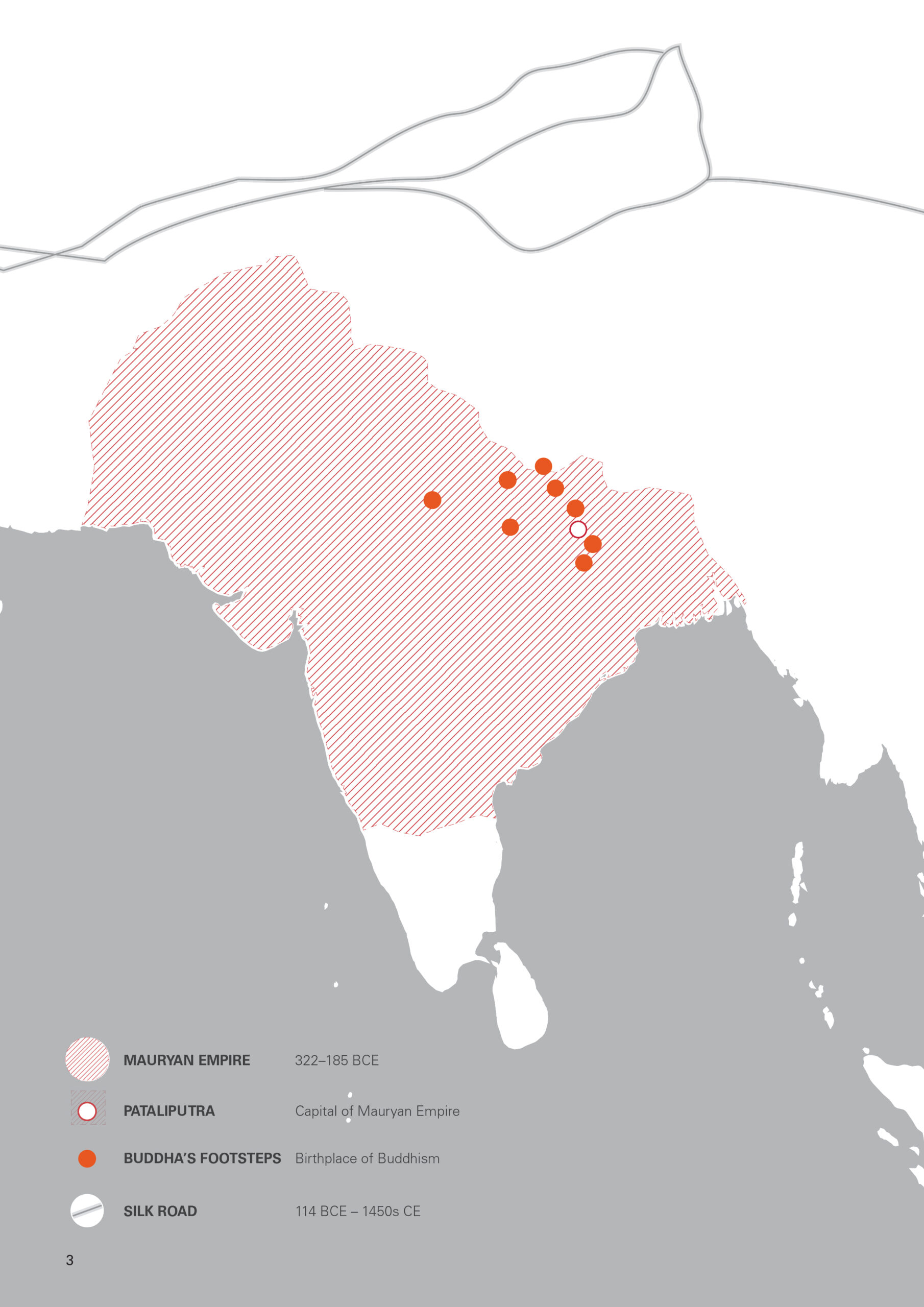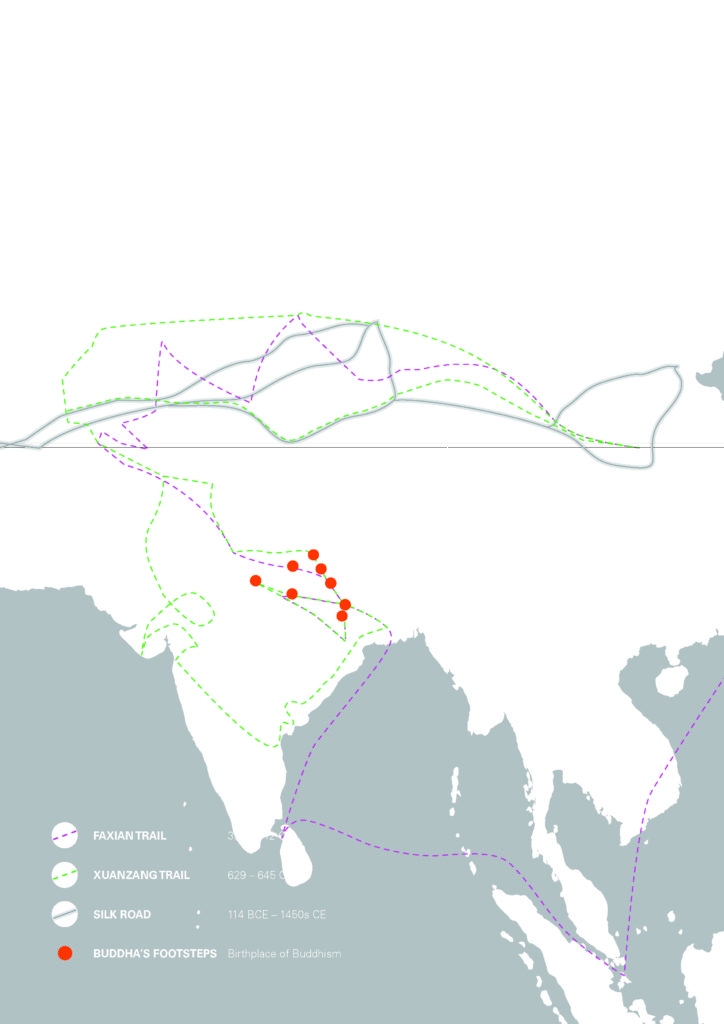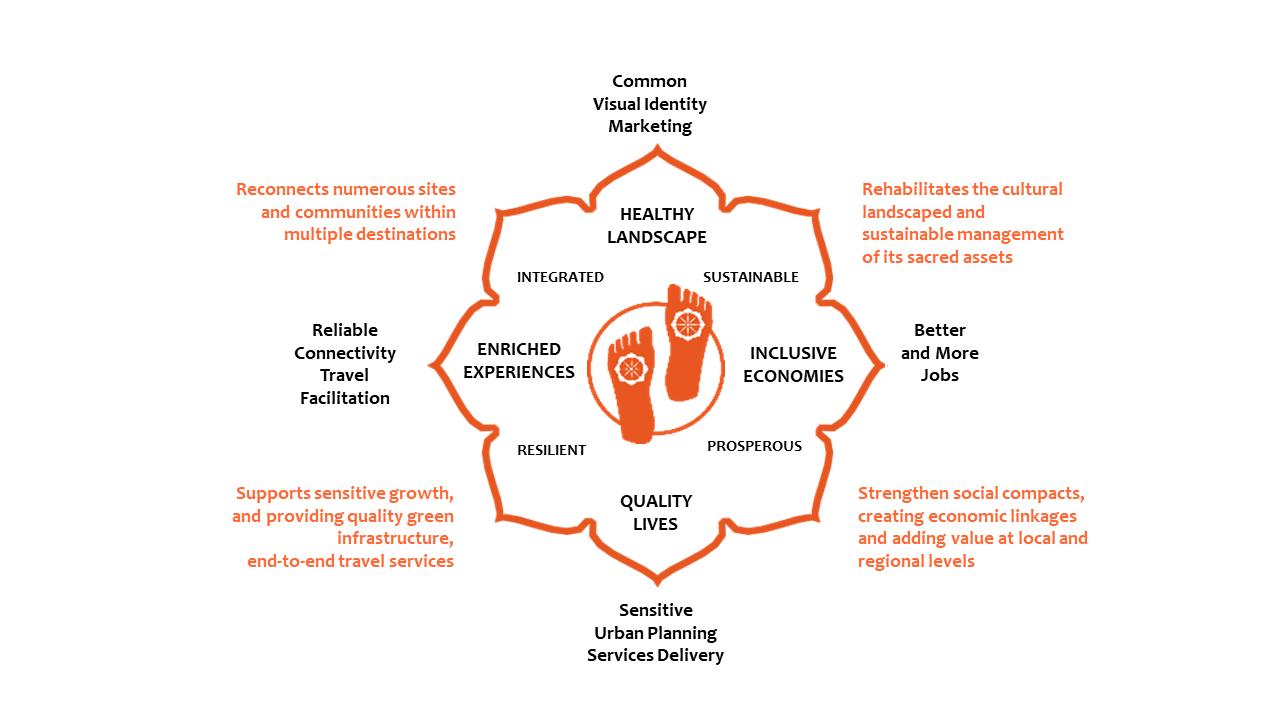Developing the Buddhist Circuit
The Buddhist Circuit is a route that follows in the footsteps of the historical Buddha in Nepal and India and retraces the spread of Buddhism within South Asia. Following historical events, the circuit presents an “inner circle” where Buddhism was born, and an “outer circle” throughout which Buddhism spread.

The inner circle comprises of places that are directly linked to some of Buddha’s most significant life events, including Lumbini in Nepal where he was born, Bodh Gaya in Bihar, India, where he attained enlightenment, Sarnath in Uttar Pradesh, India, where he gave his first sermon and Kushinagar in Uttar Pradesh where he attained Mahaparinirvana. Four additional significant places – Rajgir and Vaishali in Bihar and Sravasti and Sankasia in Uttar Pradesh complete the inner circle.

The outer circle recounts Buddhism spread across Asia, starting with the Mauryan Emperor Ashoka (268 to 232 BCE), who shaped his empire based on Buddhist precepts. He is said to have erected over 84,000 stupas, pillars and rock edicts across his empire, some of which were inscribed with royal encouragements to his subjects to live in harmony with one another. About 20 pillars still stand today. Using the Silk Road, one of the oldest trading routes connecting Persia with China, scholars, pilgrims and missionaries sponsored by Emperor Ashoka had access to faraway lands, erecting monasteries, statues, inscriptions on rock faces and sharing the teachings of the Buddha.

This made the Silk Road not only one of the most vibrant trade corridors of the time, but also a vehicle for social and cultural exchange and adoption of Buddhism beyond South Asia. Of the eminent figures who travelled the Silk Route, two are seen as the most important for the history of Buddhism. The Chinese Buddhist monks, Faxian (337 AD – 422 AD) and Xuan Zang (602 AD – 664 AD) walked thousands of kilometers from China to South Asia and visited a number of Buddhist places in today’s India, Nepal, Bangladesh, Pakistan, Afghanistan and Sri Lanka. During their journeys, they collected Buddhist scriptures and immersed into teachings, later taking them back to China for translation and dissemination, further spreading Buddhism across East Asia.
“There are four places the sight of which should arouse emotion in the faithful. Which are they? “Here the Tathagata was born” is the first. “Here the Tathagata attained supreme enlightenment” is the second. “Here the Tathagata set in motion the Wheel of Dhamma” is the third. “Here the Tathagata attained the Nibbana-element without remainder” is the fourth. And the faithful monks and nuns, male and female lay-followers will visit those places.”
— The Buddha, Mahaparinibbana Sutta: 16
Understanding the Challenges Today
Despite its significance, the Buddhist Circuit in South Asia is one of the most fragmented and underdeveloped pilgrimage and tourism routes in the world.
- Of over 520 million Buddhists, only 0.0005% visit the South Asian Buddhist places yearly.This statistic sharply contrasts to some 15% of all Christians who visit Jerusalem yearly.
- Buddhist destinations cut across some of the poorest areas in the region. one quarter of the local population lives below the poverty line and lacks access to basic services, mobility and socioeconomic opportunities.
- Gender disparities are evident. While tourism employs about 50% women globally, the corresponding number is between 2% and 5% in Buddhist destinations in South Asia. Women and girls are also subject to gender-based discrimination and violence.
- Negligible local economic benefits. Less than 5% of tourists’ total expenditure reach local communities either in terms of jobs or purchase of products and services locally provided.
- Very low quality of life low among local residents in most Buddhist destinations.Investments in basic services for both residents and tourists have been minimal. Most sites are surrounded by towns or cities with inadequate hygiene, health and safety standards.
- Degrading ecology due to ad-hoc provision of infrastructure and chaotic urban sprawl. Grasslands, wetlands and forests are being converted into urban and industrial areas without the necessary environmental safeguards, polluting and impacting ground water sources, river systems, biodiversity and people’s health. Hit and run tourism model further damaging the Circuit. Such deteriorating socioeconomic and environmental conditions have been aggravated by the competing use of already strained local services by tourists, leading to resentment among residents, poverty traps and unfulfilled visitors’ satisfaction.
Prior Attempts to Develop the Buddhist Circuit
The Buddhist Circuit has been planned and supported for about five decades. Yet, previous actions have been largely limited both geographically and scope-wise. The Buddha’s earthly journey has been narrowly interpreted and disjoined into isolated and fenced-off site-level interventions, which have neither fully contemplated the significance of each place nor located them in their broader historical, spiritual and physical contexts.
Previous plans and investments have also not established socioeconomic linkages between Buddhist assets and local communities, focusing mostly on the construction of mega projects, hotels and beautifying sites for presentation and the comfort of tourists. The communities, who live in and around the sites, have been mostly excluded from decision making and benefits, which have diminished their sense of ownership and responsibility for the stewardship of these sacred places and their surrounding cultural landscape. The resulting fragmented interventions, inadequate interpretation and limited attractions offer followers and visitors today only a narrow understanding of the Buddhist heritage and fail to establish an overall identity for its wealth of assets and meaning, ultimately weakening the integrity of the Buddhist Circuit as a driver of prosperity and livability for all.
Unlocking the Potential
South Asia’s distinguished Buddhist heritage, if well planned, protected and managed, represents a unique opportunity for reducing poverty across the region by bringing a wide spectrum of jobs and improved services to the doorstep of impoverished villages and cities. The Buddhist Circuit also offers a rare opportunity to rescue and better steward the region’s cultural assets and natural endowments, catering to the aspirations of its communities, Buddhists and visitors to come for a healthier physical and spiritual life.
To achieve it, the Buddhist Circuit Strategy serves as a guide for South Asian governments to come together with the Buddhist community, development and conservation partners, private investors, residents and others to develop it in a way that transforms the wellbeing of its communities, assets, ecosystems and visitors.
Given the context of South Asia and the current status of development and protection of its Buddhist heritage, the Strategy focuses on incremental, yet concrete steps to unlock its potential for increased prosperity and livability. It offers practical options for policy makers, investors and sympathizers in the region and beyond to address the major constrains hindering the development of the Circuit and the protection of its cultural landscape and sacred assets today and for a prosperous and livable future.
The Strategy is structured around seven core elements to inform collective decision making and action, as follows:
The Assets
The Buddhist Circuit’s comprises of three distinguished elements, namely:
- 2,600 years of History. The Buddha’s legacy has influenced civilizations and people over millennia. His way of life and teachings have been studied, adopted and carried over by scholars, devotees, lay women and men, emperors and royals. Such evolving history and traditions have been imprinted in a wealth of sites, artifacts and expressions across India, Nepal, Bhutan, Bangladesh, Pakistan, Afghanistan and Sri Lanka thanks to his disciples, Emperor Ashoka and so many others who followed.
- A spiritual tradition of tolerance and diversity. Buddhism is the world’s fourth largest religion with over 520 million followers, or over 7% of the global population. Buddhism embraces a range of traditions, beliefs and spiritual practices based on original teachings attributed to the Buddha and the resulting interpreted philosophies. Buddhism is also inferred as a “way of life” centered on Buddha’s “dharma”, kindness, patience, generosity and compassion as important virtues. The many philosophies and interpretations within Buddhism, make it one of the most tolerant and evolving religions and philosophies in the world.
- Life in harmony with nature. The Buddha was born and lived in an area covered by dense forests, a distinctive riverine system and wetlands, which altogether supported a range of endogenous flora and fauna as well as migratory species. The four main happenings of the Buddha’s earthly life have been framed by nature: he was born in a forest, gained enlightenment under a Ficus tree, spread the Dharma across grasslands, forests and water bodies, and reached Mahaparinirvana under a Sal tree. His teachings emphasize the importance of living in peace and balance with nature; the interconnectedness and interdependencies between living and non-living beings.
The Demand
With about 520 million Buddhists who strive to visit South Asian’s most sacred places in their lifetime, the Buddhist Circuit market potential is unmatched.
The Asia Pacific, in particular, holds the greatest potential, as it is home to 98% of the global Buddhist population and was driving tourism growth globally. Pre-COVID, Buddhist countries comprised more than 18% of the total foreign tourist arrivals to India, and the forecast on international outbound trips from the top Asia Pacific markets was:
Domestic visitors to the Buddhist places in South Asia were the majority with at a ratio of 3:1 to foreign visitors. With India in the lead, in 2019, about 1.8 billion domestic trips were made within the country and 22.5 million Indians traveled abroad, spending an estimated USD 23 billion. In the same year, about 5 million domestic trips took place within Nepal.

The Opportunity
The tourism sector has been hit hard by COVID-19 with the stoppage of travel and closing of all destinations worldwide in 2020. The pandemic, however, is also leading to major—and most required—changes in the sector, placing the Buddhist Circuit in South Asia in a potentially comparative advantage. The significance of the Buddhist Circuit, on the one hand, and its underdevelopment, on the other hand, provide the opportunity to develop it better almost from scratch.
In addition, visitors are changing their preferences for healthier destinations, where Buddhist precepts of caring for nature and empathy for people are given precedence over artificial embellishments and experiences. Visitors are also searching for places where they feel safe and in harmony with a clean environment; where they have access to reliable services; and, above all, where they can relate and rejoice with thriving residents. South Asia’s growing middle class also provides a major opportunity for the quicker recovery of tourism and re-opening of its sacred Buddhist destinations.
Main Issues to be Addressed
To inform the Strategy making and ensure that it addresses the major issues hindering the development of the Buddhist Circuit while unlocking its potential, scholarly research, desk reviews, in-situ assessments and profiling of the main places associated with the Buddha’s life in the region were conducted. To assure their relevance and accuracy, a series of dialogues and consultations were carried out with policy makers, monastics, scholars, professionals, private investors and residents. Throughout this comprehensive process, a number of issues affecting the development of the Buddhist Circuit have been identified.
Chief among them are:
- There is no established circuit, despite decades of planning and investments. Previous actions have led to physical interventions that are insensitive to the Buddha’s historical, social, and natural contexts and are aesthetically inconsistent across places. These interventions also lack appeal to residents and visitors and fail to address the most urgent needs of the destinations—from services to economic opportunities and the conservation of fragile natural assets and cultural landscapes.
- Planning and implementation of investments have been ineffective resulting in chaotic urban growth and poor-quality services for residents and visitors. This has not only compromised local living standards, but also hindered visitation. Limited coordination among government agencies, mistrust between public and private stakeholders and neglect of local communities in decision-making and resource allocation have severely constrained the development of the Circuit. Individual sites, even within a destination, are managed by different agencies in isolation from each other, many times leading to conflicting results. Such interventions have been detrimental to the character and integrity of individual sites and places, and further fragmented the Circuit.
- Lack of a shared identity for the Circuit as a whole and poorly interpreted sites, which had not only misrepresented the Buddha’s teachings and life but failed to depict one of South Asia’s most significant cultural and spiritual assets. Except for Sarnath and Bodhgaya, the majority of non-Buddhists typically lack awareness of most sites due to ineffective promotion as well as disparate and narrow interpretation of the multi-location route. Only a fraction of sites, assets and stories are properly mapped, studied and presented.
- Business climate bottlenecks push away private investment. Private investors are, in most cases, entrapped in a web of inefficiencies and leakages, undermining their readiness and capacity to invest and leverage public investments. In some states in India, more than 50 licenses are required from more than 15 different public departments and agencies for a private investor to build and operate a three-star hotel in a Buddhist destination. The all-inclusive packaging of tourism in the Buddhist Circuit has contributed very little to the local economies. With most services purchased upfront in the country of origin of tourists and devotees or major cities outside the destinations per se, about 75% of the wealth generated by foreign visitors remain abroad or leave South Asia. Along with the lack of activities and often subpar services provided locally, this has led to very few benefits accruing to local residents who are among the poorest in the region.
Goals and Targets
The Buddhist Circuit as a multi-location and multi-experience route aims to take devotees and visitors on a journey within journeys: personal, spiritual, cultural, ecological. No matter where those journeys will begin or end, they are expected to offer discoveries both of the self and of the countries, landscapes, histories and people they will encounter, experience and transform with.
To this end, the Buddhist Circuit needs to be positioned as an authentic and immersive route with lasting local benefits. A route that rescues the balance between nature and people and unlocks opportunities for residents, visitors and the Buddhist community at large to live, work, learn from and care for each other with empathy and joy.
By doing so, the Strategy is expected to contribute to the following broader outcomes:
- Healthy landscape: Rescued, restored and adequately managed one of South Asia’s most sacred cultural landscapes.
- Quality lives: Delivered sensitive infrastructure and services in areas previously overlooked by leisure tourism and traditional development schemes.
- Prosperous economies: Increased socioeconomic resilience of some of the region’s poorest communities, in particular women and youth.
- Enriched experiences: Deepened visitors’ journeys through the Buddha’s way of life, teachings and landscape.
The current living conditions and economic opportunities in Buddhist destinations in the region are so low that outcomes are expected to lead to transformative targets by 2035:
- Rehabilitated assets by 25%
- Reduced travel time by 50%
- Improve living conditions by 100%
- Increased local income by 100%
- Increased visitation from 0.0005% to 0.005%
Guiding Principles
With these goals in mind, the Strategy was formulated according to a set of guiding principles based on global standards applied to the inclusive and sustainable development of pilgrimage and tourism routes.
- Rescue and restore cultural landscape and its sacred assets. For visitors and residents alike, rescue and promote the ecological equilibrium and character of sacred places and their historic landscapes by rebalancing human and natural needs—for instance, through a large-scale tree planting program and the restoration of water bodies.
- Promote sensitive urban/rural growth and fulfilling journeys. Improve location design and development through urban-rural growth approaches that are sensitive to and enhance Buddhist heritage and context, with appropriate infrastructure, services, interpretation and usages. Connect fragmented sites, their interpretation, and surrounding communities to a holistic route, establishing a path for a wide variety of visitors to follow the footsteps of both the historical Buddha and his Sangha, in places where they have been gathering and practicing for centuries. Frame each location as a unique window onto Buddhist themes, history, concepts, and values, helping visitors to contemplate Buddhism where it was born and flourished.
- Strengthen local identity and responsibility. Integrate efforts that engage local populations in the definition of shared uses of sites, fostering a locally grounded identity and enhancing the stewardship of sites and their surrounding areas for generations to come.
- Enhance quality of life and visitor experience. Encourage sustainable solutions to promote pedestrian-friendly public spaces by supporting safe walking, meditation, gathering, and recreation while reducing carbon emissions. Integrate smart infrastructure technologies that transform the quality of life and health for local communities and improve overall visitor experiences.
The Approach
Circuit-based routes are different from traditional leisure tourism no matter its thematic focus, whether cultural, ecological, adventure or religious tourism. They encompass all their individual emphasis—culture, nature, traditions, people—while reconnecting and creating new meanings to them.
Circuit routes:
- Have a self-identity and emphasize the meaning and authenticity of the experience.
- Highlight experiences gained along the way —the circuit and its destinations may be experienced separately.
- Depend on spiritual, cultural and economic products available to fulfill representation of the pursuit of the self.
- Regardless of scale, have itineraries that combine self and spiritual pursuits with cultural exchanges in points of sale absorbed into local assets and history.
Based on this distinction, a fourfold approach was adopted for the Buddhist Circuit:
- Reconnecting numerous sites and communities within multiple destinations.
- Rehabilitating the cultural landscape and sustainably managing its assets.
- Supporting sensitive growth and green infrastructure and providing high quality end-to-end basic and travel services.
- Strengthen social compacts, creating economic linkages and adding value at local and regional levels.
The Strategy in a Nutshell

Incremental Implementation
To implement the Strategy and achieve the Buddhist Circuit’s goals and targets set by 2035, the sustained collaboration among the monastic community, dedicated local citizens and their organizations, government agencies and committed private investors is essential. The Strategy provides spatial targets and stepwise actions at Circuit and sites levels for governments to weave individual efforts into fulfilling collaborations.
Spatial Targeting
In the 45 years of teachings that followed his enlightenment in Bodhgaya, and his first sermon delivered in Sarnath, the Buddha wandered an area equivalent to 200,000 square kilometers—from the Himalayan foothills in the north to the southern edge of the Ganges watershed; from Bangladesh’s border in the east to Mathura in the west—meeting as many people as possible to help them to find the way out of universal suffering.
Given the size and complexity of the Buddhist Circuit with its multiple locations and stakeholders, the proposed short-, medium- and long-term actions will be implemented simultaneously at two levels:
- At Circuit level, actions focus on shared cross-border branding, promotion, connectivity and financing.
- At Destinations level, actions focus on planning and delivering end-to-end services and infrastructure in each destination as well as growing the local economies.
Overarching Pillars
Four interrelated pillars will guide the implementation of the Buddhist Circuit Strategy:




Pillar 1: Integration reconnects numerous sites and peoples on the Buddhist Circuit through a common visual identity and marketing, engaging interpretation, reliable connectivity and travel facilitation.
Pillar 2: Sustainability emphasizes the long-term integrity of the Buddhist Circuit as a living and evolving cultural landscape by rescuing and rehabilitating its cultural landscape and incentivizing its collective custodianship.
Pillar 3: Resilience embraces sensitive planning, design and urban growth, and provides high quality green and universal infrastructure for a healthier environment, communities and visitors.
Pillar 4: Inclusion strengthens social compacts and revitalizes local economies by supporting circular economy, creativity, entrepreneurism and fair trade.
Stepwise Actions
These pillars will be implemented through a combination of short- and medium-term results with long-term commitments. As experience shows, success in one area often inspires and leads to similar actions in adjacent areas, which, in turn, transforms more complex systems. The scope of standards develops over time. That is how the mature routes analyzed as part of this strategy formulation have successfully developed. Support to every positive local effort, starting with small, but lasting systemic changes, is thus critical to address larger and more persistent issues.
Following this logic, the Strategy outlines an incremental implementation with an expanding scope. Easier to implement actions have been identified and organized so as in a matter of a year they can have short-term impacts on the Circuit. Regular actions, such as maintenance of sites, are also sequenced to ensure that those benefits are extended over time. The structural behavioral changes that require years of commitment to be changed for sustained impacts have also been outlined. This approach to implementation is particularly important because achieving meaningful high standards and on a comprehensive basis is challenging. This especially when the flows of visitors increase dramatically in places where basic services and infrastructure are already under stress or are insufficient even for residents’ needs. Ad-hoc and scattered partial solutions have often been offered as the response in such contexts. Sometimes waste cleaned up from one area is swept to roadsides, rivers and drains—just shifting the problem. In other cases, public facilities are put in place only during major festivals. The most successful routes in the world anticipate and deal proactively with those problems to achieve their goals.
Short-Term Actions
Minimum requirements for the development of the Circuit:
Unifying the Circuit’s identity
- Implement the common visual identity.
- Implement the shared marketing roadmap.
- Produce coherent and engaging interpretation for each site.
- Develop Visitor Interpretative Centers in each core destination on a network basis.
- Develop immersive itineraries and activities.
- Establish database informing end-to-end travel support and access to quality service providers.
- Train and certify tour operators, guides and drivers.
Enhancing core areas of each destination
- Implement the urban design guidelines for sensitive growth.
- Promote walkability and implementation of pedestrian safety measures.
- Improve vehicular flows to re-connect main sites and assets within each destination following the Buddha’s footsteps and historical accounts.
- Rehabilitate public spaces and greenery.
- Zoning of commercial areas, including street vendors, and provision of allied facilities for vendors and visitors.
- Provide safe last mile connectivity and build parking areas away from sites.
- Provide business development support to local artisans and entrepreneurs to improve products and use of local materials.
Middle-Term Actions
Broadening the tourist experience to encourage longer stays and higher spending locally through a circular economy:
Serving destinations
- Formulate urban and land use ordinance for urban areas and adjacent rural domains.
- Upgrade infrastructure, using green technologies.
- Facilitate intra-governmental coordination for delivery of quality basic services (water, sanitation and solid waste management).
- Provide accommodation mix to attend different markets and preferences.
Facilitating sub-regional travel
- Facilitate border crossing of people and goods.
- Enhance services at borders.
- Prepare plan for multimodal connectivity (air, road, train and bus).
Long-Term Commitments
Ensuring the sustained operation and maintenance of all interventions:
Authentic and quality services
- Continue delivery of quality basic services at destinations level.
- Certify service providers and businesses.
Connecting markets
- Open skies.
- Implement multi-modal connectivity plan.
Ultimately, through a concerted effort, the South Asian Buddhist Circuit will offer:
- A variety of transformational and immersive activities along its multiple sites, destinations and cultural landscape.
- World class engaging interpretation connecting sites and historical events, bringing people together while creating a close relationship between people, nature and their cultural landscape.
- Excellent tourism infrastructure and services for residents and visitors alike.
